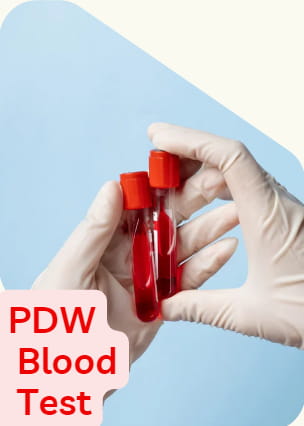Summary :
PDW, Platelet Distribution Width , is a blood test that measures the size variation of platelets in the bloodstream. Learn more about PDW test, the procedure, normal and abnormal results, and other blood tests that aid in diagnosis.
◉ Definition
Platelet distribution width (PDW) test is a measure of the variation in platelet size, and can be used as an indicator of platelet activation and the presence of platelet disorders.
It is often reported as part of a complete blood count (CBC) test, which also measures the number and size of red blood cells, white blood cells and platelets.
This test provides valuable insights into platelet function and can assist healthcare professionals in diagnosing and monitoring various health conditions.

◉ What is the importance of platelets in the body?
Platelets are special blood cells that help stop bleeding by forming clots at the site of damaged blood vessels. They are essential for wound healing and preventing blood loss.
◉ What is the purpose of the PDW blood test?
PDW blood test can be used as a prognostic marker and a guide for further diagnostic tests and treatments for various medical conditions and disorders, including:
- Platelet Disorders: PDW has been found to be useful in distinguishing essential thrombocythemia (increased PDW) from reactive thrombocytosis (normal PDW).
- Cardiovascular Diseases: PDW may serve as a potential prognostic marker for cardiovascular diseases, including coronary artery disease, myocardial infarction, and stroke.
- Inflammatory Conditions: Platelet distribution width can be influenced by inflammatory processes in the body, such as sepsis, rheumatoid arthritis, and inflammatory bowel disease.
- Cancer: PDW has been investigated as a potential biomarker for certain types of cancer, such as colorectal cancer, lung cancer, and pancreatic cancer.
◉ PDW Blood Test Steps
Performing the PDW blood test involves the following steps:
- Blood Sample Collection : A healthcare professional will collect a blood sample from a vein in the arm using a needle. This process is known as venipuncture.
- Laboratory Analysis : The collected blood sample is sent to a laboratory for analysis.
- Result Interpretation : The laboratory will provide the PDW test result, which a healthcare provider will evaluate to assess platelet health and potential underlying conditions.
◉ Normal range of PDW test
The reference range for Platelet Distribution Width is typically reported as a percentage and falls within the range 9 and 17fl.
Note:
- The normal range for Platelet Distribution Width (PDW) can vary slightly depending on the laboratory and the specific blood analysis system used.
- Sometimes during the test, platelets stick together and the machine gives a false reading, interpreting it as fewer, larger platelets. In that case, the lab may do a blood smear and directly examine the platelets under a microscope.
◉ Interpretation of PDW test
- A normal PDW indicates platelets that are mostly the same size.
- A high PDW means that there is a wide range of platelet sizes. This may indicate that your bone marrow is producing more platelets than usual or that some of your platelets are old and worn out. Higher MPV and PDW levels also may be associated with inflammation and thyroid malignancies.
- A low PDW value means that the platelets in the blood are very uniform in size. This could indicate a problem with the bone marrow or the platelets themselves.
PDW blood test results should always be interpreted in conjunction with other diagnostic tests and medical history.
◉ High PDW
◉ High PDW : Meaning and Causes
A high PDW value means that there is a wide range of platelet sizes, indicating that some platelets are larger and younger, while others are smaller and older.
Larger platelets are usually released earlier than normal from the bone marrow, where they are produced, in response to certain conditions such as inflammation, infection or bleeding, while smaller platelets may have been in circulation for a few days and are less active.
- Essential thrombocythemia
- Aplastic anemia
- Megaloblastic anemia
- Chronic myelogenous leukemia
- Chemotherapy
- Inflammation
- Error of mesurment (ex; cas of fragmented erythrocytes).
◉ High PDW : Symptoms
- Bruising
- Rash
- Purplish spots on the skin.
- Fever and joint pain.
- Pain, fatigue and weakness.
High PDW levels may not always cause noticeable signs or symptoms, and should be interpreted in conjunction with other diagnostic tests and medical history.
◉ Low PDW
◉ High PDW : Meaning and Causes
- Viral infections
- Certain drugs
- Bone marrow disorders
- Vitamin B12 or folate deficiency can affect the production of platelets, leading to decreased PDW values.
◉ Other Blood Tests for Diagnosis
Some of the other tests that are related to the PDW test are:
- Platelet count (PLT): This is the number of platelets in a given volume of blood. It can indicate the risk of bleeding or clotting disorders.
- Mean platelet volume (MPV): This is the average size of platelets in the blood. It can reflect the production and activation of platelets by the bone marrow.
- Plateletcrit (PCT): This is the percentage of blood volume that is occupied by platelets.
- Platelet-large cell ratio (P-LCR): This is the percentage of platelets that are larger than the normal size.
◉ Conclusion
In summary, the platelet distribution width test provides valuable information about platelet size variability, aiding in the diagnosis and monitoring of various health conditions.
By incorporating the PDW blood test into routine blood analysis, healthcare professionals can enhance their ability to provide accurate diagnoses and personalized treatment plans for patients with platelet disorders.